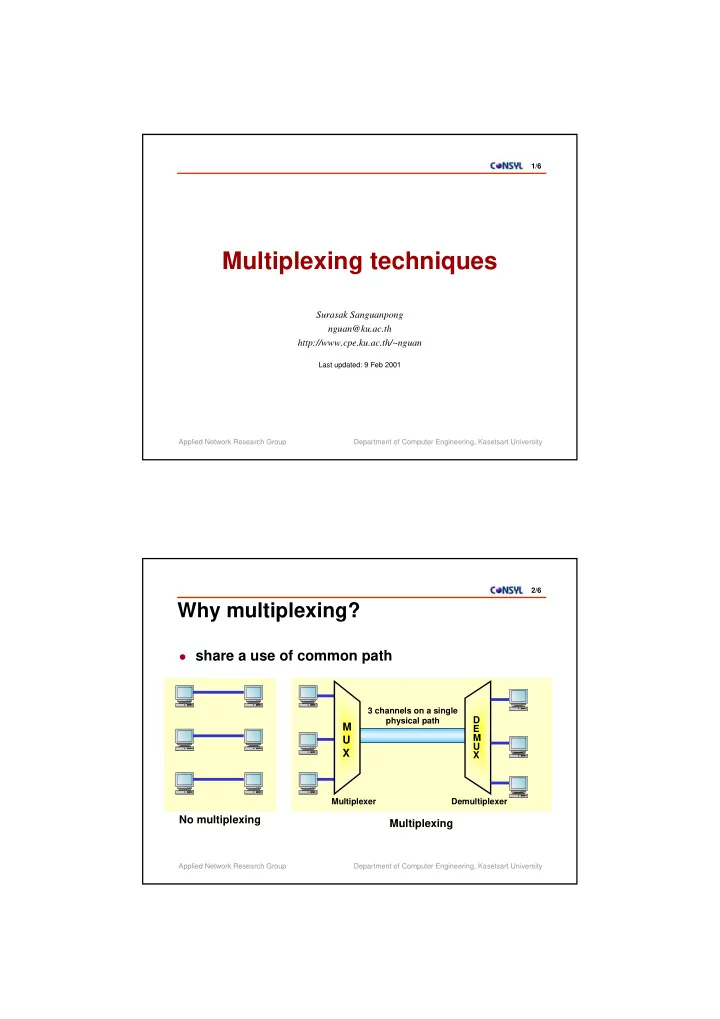

1/6 Multiplexing techniques Surasak Sanguanpong nguan@ku.ac.th http://www.cpe.ku.ac.th/~nguan Last updated: 9 Feb 2001 Applied Network Research Group Department of Computer Engineering, Kasetsart University 2/6 Why multiplexing? � share a use of common path 3 channels on a single physical path D M E M U U X X Multiplexer Demultiplexer No multiplexing Multiplexing Applied Network Research Group Department of Computer Engineering, Kasetsart University
3/6 Type of Multiplexing Frequency Division Multiplex (FDM) Frequency Division Multiplex (FDM) Multiplexing Time Division Multiplex (TDM) Time Division Multiplex (TDM) Synchronous Synchronous Asynchronous Asynchronous Wavelength Division Multiplex (WDM) Wavelength Division Multiplex (WDM) Applied Network Research Group Department of Computer Engineering, Kasetsart University 4/6 Frequency Division Multiplex D Channel 1 M E M U Channel 2 U X X Channel 3 Applied Network Research Group Department of Computer Engineering, Kasetsart University
5/6 FDM MUX/DEMUX Each signal is decompose the original ouput multiplexed modulated to a different signal signal carrier frequency signal with filters CH1 CH1 CH1 CH2 CH3 CH2 CH2 + CH3 CH3 Applied Network Research Group Department of Computer Engineering, Kasetsart University 6/6 Time Division Multiplex D M E 1 2 3 M U U X X Applied Network Research Group Department of Computer Engineering, Kasetsart University
7/6 TDM MUX/DEMUX CH1 CH1 1 2 3 CH2 CH2 CH3 CH3 • Multiple digital signals interleaved in time • May be at bit level of blocks • Time slots pre-assigned to sources and fixed Applied Network Research Group Department of Computer Engineering, Kasetsart University 8/6 Asynchronous TDM Also called Statistical TDM t 1 t 2 t 3 waste bandwidth Synchronous TDM A A 1 B 1 C 1 D 1 A 2 B 2 C 2 D 2 B 1 st cycle C 2 nd cycle D extra bandwidth available Asynchronous TDM Data to be sent A 1 B 1 B 2 C 2 1 st cycle 2 nd cycle Applied Network Research Group Department of Computer Engineering, Kasetsart University
9/6 TDM in the Telephone System How much bandwidth is required for 32 voice channels? D M E Data rate = 8 bits * 8000 KHz 1 2 3 . . N M U = 64 Kbps U Bandwidth = 64 Kbps * 32 X X = 2.048 Mbps Most common application of TDM is in the telephone � system Analog voice signals are digitized using PCM � Applied Network Research Group Department of Computer Engineering, Kasetsart University 10/6 Wavelength Division Multiplexing Wave which has wavelength between λ x and λ y λ x λ y λ 1 λ 2 λ 1 λ 2 D M E M U λ 3 λ 4 U λ 3 λ 4 X X λ 5 λ 6 λ 5 λ 6 Applied Network Research Group Department of Computer Engineering, Kasetsart University
11/6 Inverse Multiplexing D M E 1 2 3 M U U X X Applied Network Research Group Department of Computer Engineering, Kasetsart University 12/6 Analog Carrier System 48 KHz 4 KHz North American 12 Voice Channels FDM Carrier Standard Group 240 KHz 60 Voice Channels F 2.52 MHz D Supergroup 600 Voice Channels M F Mastergroup 16.984 MHz D 3600 Voice Channels M 12 voice F Jumbogroup channels D M 57.442 MHz 5 Groups F 10800 Voice Channels D F M 10 Supergroups D M 6 Mastergroups 3 Jumbogroup Applied Network Research Group Department of Computer Engineering, Kasetsart University
13/6 Digital Carrier System North American 64 Kbps 1.544 Mbps TDM Carrier Standard DS0 24 Voice Channels 6.312 Mbps DS1 96 Voice Channels T 44.376 Mbps D DS2 672 Voice Channels M T 274.176 Mbps D DS3 4032 Voice Channels M 24 voice T channels DS4 D M 4 DS1 T D M 7 DS2 6 DS3 Applied Network Research Group Department of Computer Engineering, Kasetsart University
Recommend
More recommend